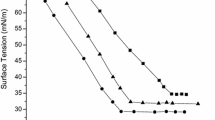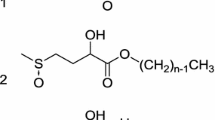Abstract
We report the synthesis, characterization and micellization properties of two anionic reactive surfactants based on 3-pentadecyl phenol obtainable from a renewable resource, cardanol. The synthesis is achieved through simple chemical transformations, first converting the phenol to the acrylate that is sulfonated in a second step. The products were characterized by elemental analysis and spectroscopic techniques. The surfactant properties of the sulfonated acrylates were measured and compared with the standard non-reactive anionic surfactant sodium dodecyl sulfonate. The micellization behavior of aqueous solutions was studied using conductivity, surface tension measurements, and the fluorescence probe technique based on diphenyl hexatriene. Characterization by surface tension measurements facilitated the determination of basic surfactant properties like the critical micelle concentration (CMC), the surface tension at the CMC, surface excess and area per surfactant molecule. The Gibbs free energy of micellization showed a negative value suggesting spontaneous micellization in aqueous solution. The micellization of the surfmer with an ethylene spacer between the phenyl ring and the acrylate group seems to be enhanced as indicated by the lower surface excess and lower free energy. Its CMC was also lower.





Similar content being viewed by others
References
Paramashivappa R, Kumar P, Vithayathil P, Rao A (2001) Novel method for isolation of major phenolic constituents from cashew (Anacardium Occidentale L.) nut shell liquid. J Agric Food Chem 49:2548–2551
Gedam PH, Sampathkumaran PS (1986) Cashew nut shell liquid: extraction, chemistry and applications. Prog Org Coat 14:115–157
Izzo P, Dawson C (1949) Cashew nut shell liquid. VI: the olefinic nature of anacardic acid. J Org Chem 14:1039–1047
George J, Pillai CKS (1993) Synthesis and characterization of a self crosslinkable polymer from cardanol: autoxidation of poly(cardanyl acrylate) to a crosslinked film. J Polym Sci Polym Chem 31:1069
Suresh KI, Kishanprasad VS (2005) Synthesis, structure and properties of novel polyols from cardanol and developed polyurethanes. Ind Eng Chem Res 44:4504–4512
Suresh KI, Jaikrishna M (2005) Synthesis of novel crosslinkable polymers by atom transfer radical polymerization of cardanyl acrylate. J Polym Sci Polym Chem 43:5953–5961
Aggarwal LK, Tapliyal PC, Karade SR (2007) Anticorrosive properties of epoxy cardanol based paints. Prog Org Coat 59:76–80
Huong NL, Nieu NH, Tan TT, Griesser UJ (1996) Cardanol-phenol-formaldehyde resins—thermal analysis and characterization. Angew Makromol Chemie 243:77–85
Parameswaran PS, Abraham BT, Thachil ET (2010) Cardanol-based resol phenolics—a comparative study. Prog Rubber Plast Recycl Technol 26:31–50
Bruce IE, Mehta L, Porter MJ, Stein BK, Tyman JHP (2009) Anionic surfactants synthesized from replenishable phenolic lipids. J Surfactants Deterg 12:337–344
Lubi M, Thachil E (2000) Cashew nut shell liquid—a versatile monomer for polymer synthesis. Des Monom Polym 3:123–153
Tyman J (2005) Researches on the technology and bioactive properties of phenolic lipids. Frontiers Nat Prod Chem 1:107–120
Tyman JHP, Bruce IE (2003) Synthesis and characterization of polyethoxylate surfactants derived from phenolic lipids. J Surfactants Deterg 6:291–297
Tyman JHP, Bruce IE (2004) Surfactant properties and biodegradation of polyethoxylates from phenolic lipids. J Surfactants Deterg 7:169–173
Stasiuk M, Kozubek A (2010) Biological activity of phenolic lipids. Cell Mol Life Sci 67:841–860
Scorzza C, Nieves J, Vejar F, Bullon J (2010) Synthesis and physicochemical characterization of anionic surfactant derived from cashew nut shell oil. J Surfactants Deterg 13:27–31
Dantas TNC, Vale TYF, Neto AAD, Scatena H, Moura MCPA (2009) Micellization study and adsorption properties of an anionic surfactant synthesized from hydrogenated cardanol in air-water and in air-brine interfaces. Colloid Polym Sci 287:81–87
Guyot A (2004) Advances in reactive surfactants. Adv Colloid Interface Sci 108:3–22
Wolfgang B, Patrick T (2005) Use of copolymerisable surfactants in the emulsion polymerization (E.P. 1,512,703)
Peungjitton P, Sangvanich P, Pornpakakul S, Petsom A, Reongsumran S (2009) Sodium cardanol sulfonate surfactant from cashew nut shell liquid. J Surfactants Deterg 12:85–89
van Os NM, Daane GJ, Bolsman TABM (1982) The effect of chemical structure upon the thermodynamics of micellization of model alkylarene sulphonates I. Sodium p-(x-Decyl) benzenesulphonate isomers. Colloids Int Sci 115(2):402–409
Bolsman TAMB, Daane GJR (1986) Effect of surfactant structure on the phase behavior of alkylxylenesulphonate/crude oil/brine systems. SPE Res Eng SPE 11770:53–60
Frumkin AN (1925) Surface tension curves of the higher fatty acids and the equation of conditions of the surface layer. Z Phys Chem 116:466–483
Small DM (1970) In: Proceedings of the symposium on “gastroenterology: physical events in lipid digestion and absorption” 53rd annual meeting of the Federation of Societies for Experimental Biology, Atlantic City, NJ April 29, pp 1320–1326
Rosen MJ, Dahanayake M (2000) Industrial utilization of surfactants: principles and practice. AOCS, Illinois
Isratov V, Kautz H, Kim YK, Schubert R, Frey H (2003) Linear-dendritic nonionic poly (propylene oxide)-poly (glycerol surfactants). Tetrahedron 59:4017–4024
Mehreteab A, Chen B (1995) Fluorescence technique for the determination of low critical micelle concentrations. J Am Oil Chem Soc 72:49–52
Rodrıguez MP, Prieto G, Rega C, Varela LM, Sarmiento F, Mosquera V (1998) A comparative study of the determination of the critical micelle concentration by conductivity and dielectric constant measurements. Langmuir 14:4422–4426
Williams RJ, Phillips JN, Mysels KJ (1955) The critical micelle concentration of sodium lauryl sulphate at 25 °C. Trans Faraday Soc 51:728
Acknowledgments
This research was supported by a Marie Curie International Incoming Fellowship to Dr. K. I. Suresh within the 7th European Community Framework Programme (FP-7).
Author information
Authors and Affiliations
Corresponding author
About this article
Cite this article
Kattimuttathu I, S., Foerst, G., Schubert, R. et al. Synthesis and Micellization Properties of New Anionic Reactive Surfactants Based on Hydrogenated Cardanol. J Surfact Deterg 15, 207–215 (2012). https://doi.org/10.1007/s11743-011-1294-z
Received:
Accepted:
Published:
Issue Date:
DOI: https://doi.org/10.1007/s11743-011-1294-z




